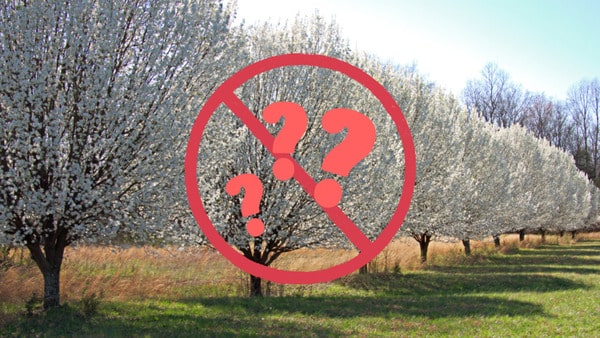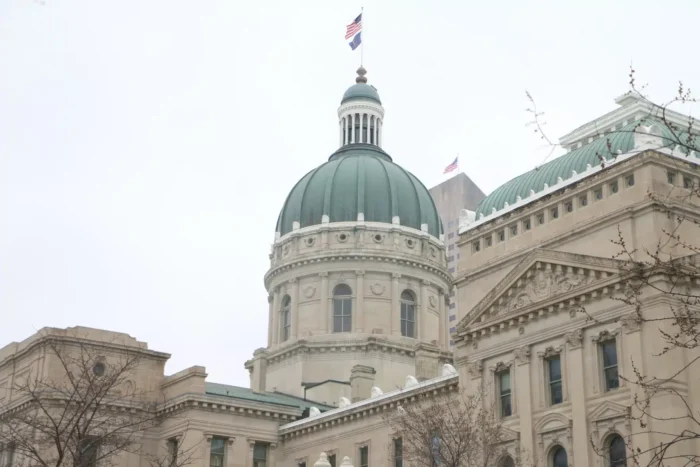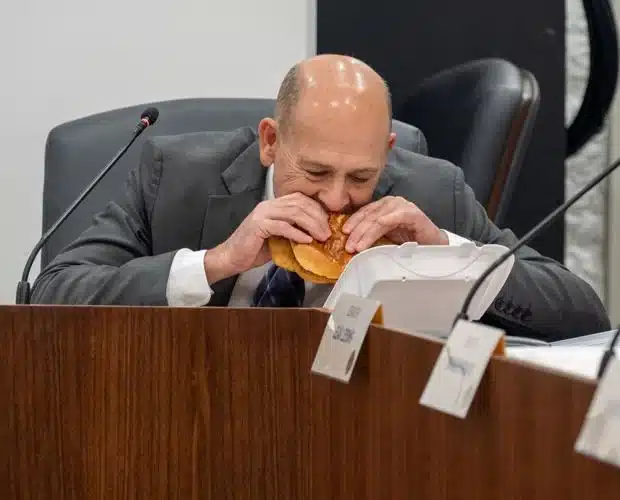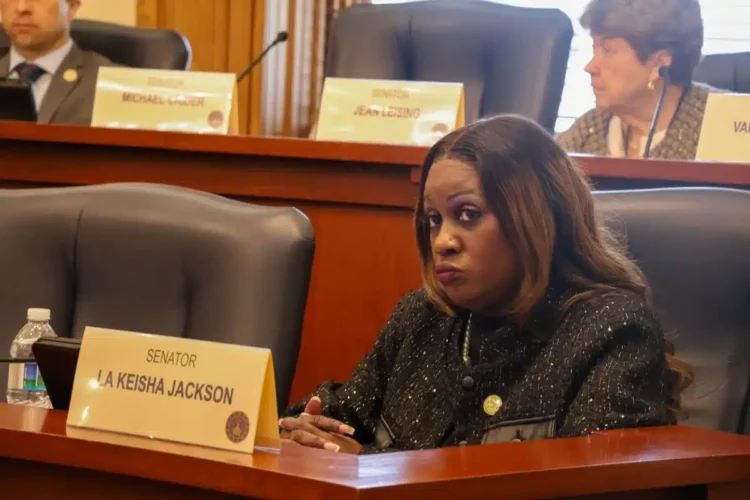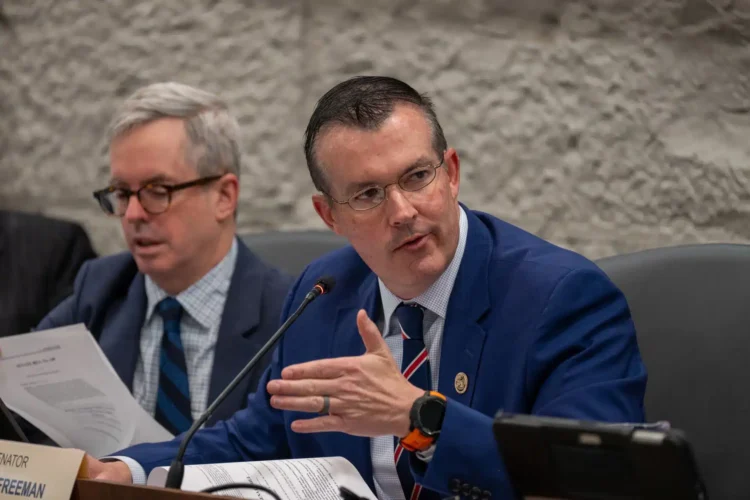The U.S. Department of Agriculture brought the Callery pear tree, commonly known as the Bradford pear, to the U.S. from Asia in 1917 to make pear trees more resistant to disease. It soon became a landscaping staple because of its fast growth, white flowers that bloom early in the spring, and leaves that turn red and purple in the fall.
But the snow-white tree that showers the ground with petals is not as pretty as it looks. The once sterile tree is now a prolific invasive species in Indiana.
“Until recently, we really didn’t have a general public that knew the Callery pear was bad,” said Megan Abraham, division director and state entomologist for the Indiana Department of Natural Resources. “I mean, it had just come out in the ‘70s. … “The Department of USDA Agriculture had promoted this sterile tree that had white flowers and blossomed in the spring, and it’s sterile so it can’t become invasive.
“What they didn’t know at the time was that it could crossbreed with other varieties and then create an issue down the road, and that’s what’s going on.”
With invasive species growing all over Indiana, Ellen Jacquart, a retired conservationist in Ellettsville, decided she had to do something about it. She recently started a petition with Change.org to ban the “Dirty Dozen” of invasive plants from being sold in Indiana. It currently has just over 4,000 signatures.
The dozen includes a lot of plants common to a home garden: Norway maple, sweet autumn clematis, burning bush, moneywort, Chinese maiden grass, wild parsnip, lesser celandine, glossy buckthorn, spreading hedge parsley, Japanese hedge parsley and European highbush cranberry.
“The biggest problem we faced in our natural areas were invasive species that were moving into the natural areas and displacing the [native plants] that we were trying to keep going,” said Jacquart. “Over time, we realized that the vast majority of the plants that we were fighting and spending significant money and time controlling were being deliberately planted by people in their yards, then escaping their yards and coming in and impacting natural areas.”
Jacquart realized this while she worked for the Nature Conservancy and started working with others to talk to plant sellers about the harm they were doing selling such plants—not only to the environment but also to taxpayers spending hundreds of thousands of dollars to remove invasive plants.
“[Plant sellers] felt the reason they were selling these plants was because the public wanted them, and if we wanted to … stop the sale of these plants, we needed to tell their customers,” said Jacquart.
So her group started a 20-year-long project assessing the invasiveness of different plants and the damage being done. They made a brochure with their findings and printed 100,000 copies, distributing them across Indiana to garden clubs, master gardeners and the like.
“And years went by after we did this, and we realized that nothing had changed, that by telling the customers, there was no way that we could tell it made any difference. So, all of the same stores were selling all the same invasive plants,” she said.
In 2009, she helped create the Indiana Invasive Species Council. After decades of documentation and educating the public with little change, Jacquart and her group went to the council to ban the plants once and for all.
“We went to them and we said, hey, listen, we’ve tried everything. We did this assessment. We have all the documentation that these species are causing harm in the state. And we tried to get customers to stop buying, and then we tried to get the sellers to stop selling them, but it’s not working. We simply need to make these illegal.”
After decades of work, in 2020, 44 plants were banned through the council’s Terrestrial Plant Rule.
“But of course, you know, time goes on. We were watching other species, species that when we first started, we hadn’t seen them be a problem. But gradually, they did become invasive,” said Jacquart.
Jacquart and her group made a new list to add to the Terrestrial Plant Rule, “the Dirty Dozen,” but the amendment drafted in 2020 hasn’t gone anywhere.
“And of course, you can imagine there are a number of excuses for why it hasn’t gone forward with everything else that happened in 2020, like COVID,” she said. “But we’re concerned that it’s never going to go forward because there are always higher priorities for the Department of Natural Resources.”
Jacquart started the Change.org petition because other divisions like fishing and wildlife have lobbyists but native plants don’t.
“There’s no lobbyists for native plants. … We need to do something, and we started with the petition,” said Jacquart. “We’re hoping to just continue the pressure to make sure the DNR knows that there are people who care about native plants, who care about the damage that is being caused by the invasive plants that are currently being sold and planted in Indiana.”
Jacquart has firsthand knowledge on the destruction the Callery pear has caused and how it has displaced native plants.
“I’ve visited sites here in southern Indiana where Callery pear is covering the understory of forest over thousands of acres, or Callery pear is the dominant young tree species,” said Jacquart. “And it means that when the mature trees die, what we’re seeing is the only thing that gets up to the canopy is the Callery pear, and so we’re ending up with these Callery pear forests, and there is no place for oaks and hickories and ash and elms and all of the native tree species.”
Political landscaping
But just like the Callery pear, with changing the law, there are more problems than meet the eye.
“Basically, the current political climate requires that the state of Indiana requires an additional research and finding be put into anything that’s going to be placed as a rule that might cause more than $500,000 worth of impact to small businesses here in Indiana,” said Abraham.
Last year a new law required government organizations like the DNR to spell out every fine or penalty imposed by their agency, which backlogged other work as well as rules the DNR wants to add, she said, adding that the law also calls for agency rules to be recodified every five instead of seven years.
“So, it’s not that I can’t issue or change the Terrestrial Plant Rule. It’s just that there’s a bunch of other things that have been happening outside of the Terrestrial Plant Rule arena that have kind of taken precedence,” Abraham said.
“I think that all the nursery industry for the most part—you do have your bad actors—has taken ownership of this and realized it’s not a good idea to sell Callery pear here in Indiana. So we do have a lot fewer producers and nursery owners that are still learning or growing Callery pear.”
Jacquart is not so optimistic.
“Well, we’re gonna continue to see it sold,” she said. “I would like to believe that sellers would stop selling this because it is clear to everyone the damage that Callery pears are causing. It’s not a secret to anyone. And so for these sellers to be continuing to sell, it just seems really ethically wrong and morally wrong.”
Cultivating a diverse future
Despite the challenges she described within her agency, Abraham found no fault with the Change.org petition.
“The petition sounds fantastic,” she said. “I cannot say anything bad about it all. I think that’s a fantastic idea for spreading awareness if nothing else.”
Dawn Slack, project coordinator for the Indiana Invasives Initiative, said petitions like Jacquart’s are important for encouraging people to take matters into their own hands.
“The people must own the problem, and then we will be the solution,” she said. “Many folks in Indiana are already taking on the challenge and working hard on their own property or volunteering at a Weed Wrangle so that our publicly accessible places—parks, preserves and other places we set aside to be left undeveloped—are truly healthy places for people and wildlife.”
Jacquart has even more ideas for the public to help conserve Indiana’s native plants.
“Join the Indiana Native Plant Society, and we do a lot of stuff to try and conserve native plants and deal with the threats that are out there that are damaging the natural communities and plants that call them home,” she said.
“And also sign our petition, of course.”

